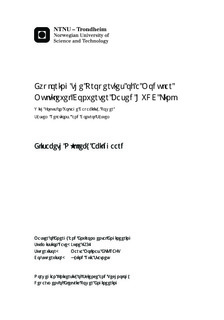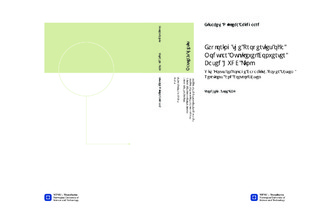| dc.contributor.advisor | Molinas, Marta | nb_NO |
| dc.contributor.advisor | Rui, Øyvind | nb_NO |
| dc.contributor.author | Abildgaard, Elisabeth Nøkleby | nb_NO |
| dc.date.accessioned | 2014-12-19T13:53:30Z | |
| dc.date.available | 2014-12-19T13:53:30Z | |
| dc.date.created | 2012-11-08 | nb_NO |
| dc.date.issued | 2012 | nb_NO |
| dc.identifier | 566416 | nb_NO |
| dc.identifier | ntnudaim:7004 | nb_NO |
| dc.identifier.uri | http://hdl.handle.net/11250/257354 | |
| dc.description.abstract | The properties of a Modular Multilevel Converter (MMC) are investigated. This is a new and promising converter type for High Voltage Direct Current (HVDC) applications. A case with a MMC connected to a stiff grid through a filter and a transformer is analysed both theoretically and in simulations, with focus on three main topics.The first topic is the available voltage at the converter terminal and modulation strategies. Theoretical evaluations are compared with simulation results. Two different methods are used to analytically investigate the relationship between modulation index and terminal voltage. The effect of third harmonic distortion is also considered. Simulations proved that the converter followed the theoretical modulation curve. Qualitative comparisons of theoretically developed voltage wave shapes with simulation results with different modulation indexes were successful, but quantitative comparisons proved challenging. Modulation with third harmonic distortion showed very convincing results in the simulations.The second topic is the power equations valid for the case circuit. Relations between active power, reactive power, grid angle, and converter voltage were investigated. A phasor approach was used in the deduction of the theoretical formulas, and these formulas were verified by the simulation results. The grid angle range giving stable operation was defined by the angle stability limit for power systems. The ratio between the resistance and the inductance in the connection was found to have a large influence on the characteristics of the connection, for instance by defining the stable operation conditions. In the theoretical analysis the magnetizing effects of the transformer were disregarded. Simulations showed that this approximation was appropriate. A surprising simulation result was that the terminal voltage of the converter was depending on the grid angle. Further investigations are needed to identify the cause and compensate for this effect.The third topic is the converter control system. The converter was modelled in the dq reference frame, and the model was used to derive and tune the control system. The control system was made with a cascaded structure, controlling either active and reactive power at the grid or active power at the gird and the rms value of the voltage at the converter terminal. The inner loops controlling the current were tuned with modulus optimum to achieve fastness. The outer loops for power were tuned to be somewhat slower than the inner loops, while the outer loop for rms value was tuned with symmetric optimum. All the control loops were successfully implemented into the simulation model. This shows that it is possible to control parameters at two different locations in the network at the same time. Simulations showed that it is possible to change the control mode between reactive power control and rms value control, without making the control system unstable. This demonstrated both successful decoupling and a robust control system. | nb_NO |
| dc.language | eng | nb_NO |
| dc.publisher | Institutt for elkraftteknikk | nb_NO |
| dc.subject | ntnudaim:7004 | no_NO |
| dc.subject | MTENERG energi og miljø | no_NO |
| dc.subject | Elektrisk energiteknikk | no_NO |
| dc.title | Exploring the Properties of a Modular Multilevel Converter Based HVDC Link: With Focus on Voltage Capability, Power System Relations, and Control System | nb_NO |
| dc.type | Master thesis | nb_NO |
| dc.source.pagenumber | 161 | nb_NO |
| dc.contributor.department | Norges teknisk-naturvitenskapelige universitet, Fakultet for informasjonsteknologi, matematikk og elektroteknikk, Institutt for elkraftteknikk | nb_NO |

